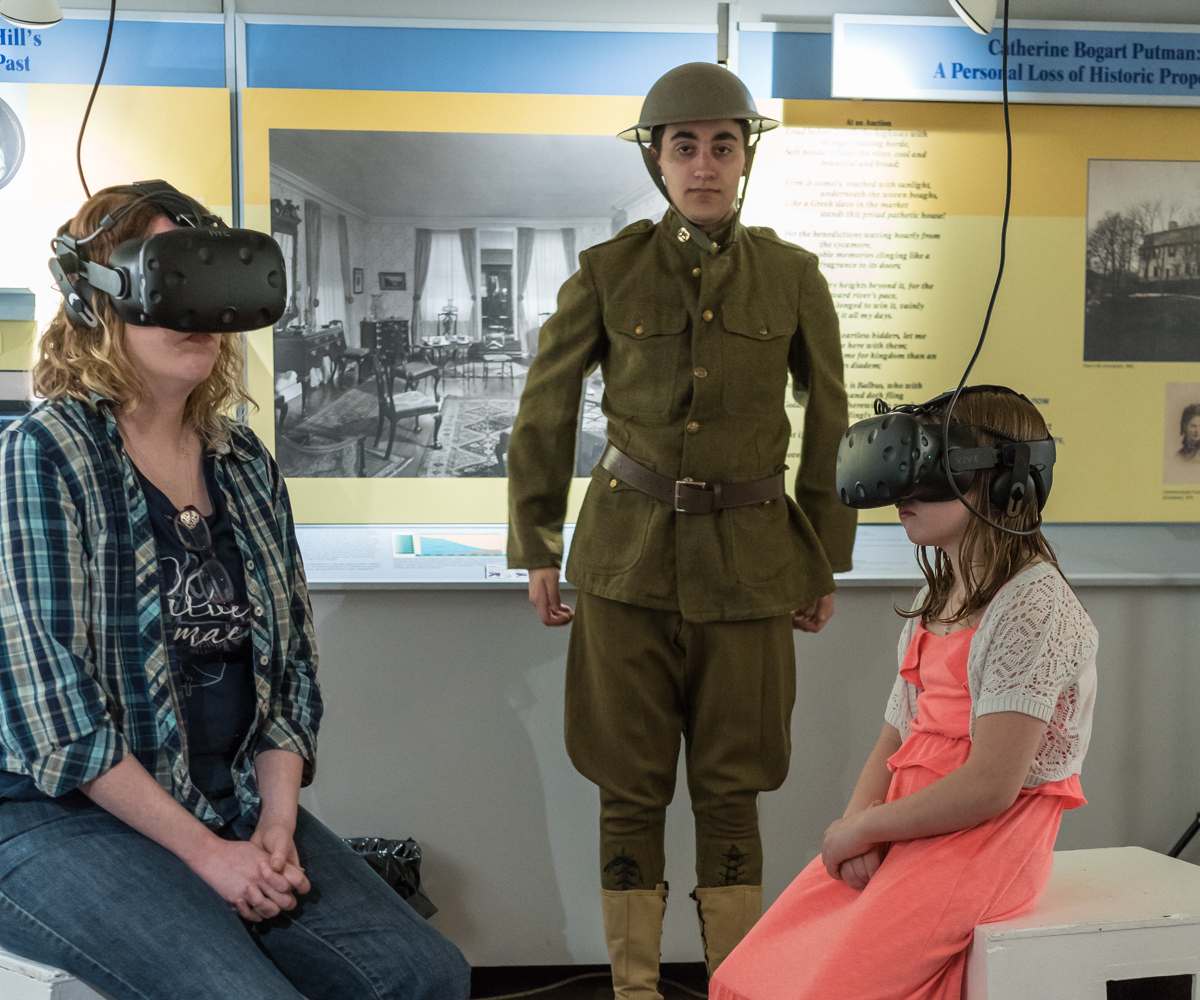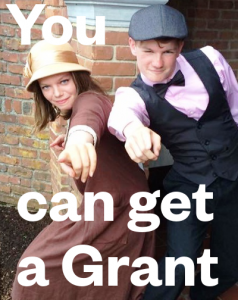Participatory experiences top the list of expectations for today’s visitors to historic house museums and other cultural institutions, which presents both challenges and opportunities for the field. One new avenue for audience engagement is the incorporation of Virtual Reality (VR) technology. Humanities New York spoke with Deborah Emmons-Andarawis, Acting Director of Historic Cherry Hill, and Krysta Dennis and Michael Lounello from Siena College’s Creative Arts Department to discuss the debut of VR at the Albany History Fair in May 2018.
Historic Cherry Hill and the college’s Creative Arts Department laid the groundwork for this VR experiment through last year’s celebration of the New York State Women’s Suffrage Centennial. Krysta wrote Votes for Women, an immersive promenade performance that highlights key moments from suffrage history. The Creative Arts Department received an Action Grant to stage the play at Siena College and Ten Broeck Mansion. Based on the success of Votes for Women, Historic Cherry Hill invited Krysta to write a one-act play about Emily Rankin, a resident of Cherry Hill who opposed the 1917 women’s suffrage legislation. The Burden of the Ballot was a popular element of the 2017 Albany History Fair, which was funded in part by an Action Grant. This year, the organizations continued their collaboration with Action Grants for the 2018 fair. Dutch, a play that traces the WWI experiences of a member of the Rankin family through both an in-person and a VR component, premiered at the fair.
HNY: What was the focus for this year’s fair, and what made it distinctive from previous years?
Deborah: This was our nineteenth annual Albany History Fair. Every year we choose a theme relevant to Albany’s history. This year our theme was “WWI: The Albany Home Front.” We chose that because of the centennial of the end of WWI and also the anniversary of the death of Herbert Rankin of Cherry Hill. Herbert enlisted in spring of 1917 and was commissioned as a captain. To the Rankin family, Herbert was continuing a family tradition of patriotism and leadership that went all the way back to his great-great grandfather Philip Van Rensselaer, who built Cherry Hill and who served in the Revolutionary War. They were extraordinarily proud of him—but, as fate would have it, Herbert never saw action; he died of influenza on board the SS Euripides before he ever reached France.
The History Fair has evolved in recent years from a day of traditional talks and presentations to becoming a truly immersive experience. I think this year was a particular accomplishment in that regard because of Dutch and the VR experience, but also because of the WWI music played on period devices and the WWI food economy pre
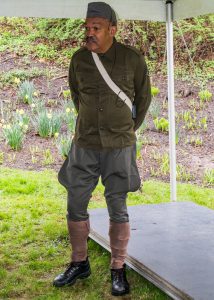
sentation with its samples of what people were cooking and eating during WWI. Whether or not that food was enjoyable is another story! But it was a very sensory fair.
HNY: How does Virtual Reality fit into the larger goals of Historic Cherry Hill’s interpretive mission?
Deborah: Virtual Reality has an amazing power to bring the past to life. It allows a type of exploration that might not otherwise might be possible. It also makes the experience of a historical object more meaningful. In a sense you have a broadened understanding of it when you encounter it.
What really makes Cherry Hill such an amazing place is that we have the real thing. Our collection of 70,000 artifacts and manuscripts is the basis for all of our programming. Compared to many other historic sites, there’s very little guesswork. We know what the family said. Those words came to life in Krysta’s play, both with live actors and the VR experience. Then visitors could go upstairs to see the actual artifacts that defined the family’s WWI experience, from Herbert Rankin’s uniform and the personal effects that were sent back to the family after he died, to Catherine Rankin’s black dress that she probably wore while in mourning. That encounter with the past is almost a spiritual experience. It’s very different from the Virtual Reality experience, but they feed one another.
Part of our angle on interpretation is that we want visitors to emotionally connect with the family. We want them to see the family as real people and to sympathize with, or even like them. But also we want to establish critical distance so that visitors can examine the perspectives of the family members and the choices that they made. The play was really effective in forging that emotional connection. So many people commented that they were almost moved to tears during the play. Being able to establish that emotional connection with these historic characters enables people to not simply write them off or villanize them for some of their shocking views. That’s valuable even in navigating our relationships in our world today.
HNY: Putting people into a digital world with a headset offers lots of possibilities for creating a unique educational experience. It also requires a different perspective than traditional exhibition design; instead of directing a visitor’s attention you have to create an environment that gives them choices for how they want to interact. For many organizations this can be daunting. What inspired the Creative Arts Department to propose the use of VR at the History Fair, and how did you approach this technology?
Mike: When I first met Krysta, she would tell me that there’s no educational value to video games and these sorts of things. I own a VR headset, and I brought it to school and said, “Try this. Tell me it can’t be educational.” She fell in love with it. There are pieces of gaming in general–whether it’s video games or board games–that are theatrical, and tell a story, and can revolve around history and a multitude of different things
Krysta: I still hate games. I have no interest in any of that. But as soon as Mike put me in that headset–he put me in this under-the-sea thing–you’re going down in a cage as if you were scuba diving and seeing all of these things all around you. I went, “Oh my God!” What a wonderful tool for theatre-making, what a wonderful tool for accessing the past and historical moments. I am an early embracer of all things technological in theatre because I know that Mike can do them. The moment I put on that headset, I saw infinite possibilities for historic spaces, for interpretation and curation, and theatre-making.
HNY: How does Virtual Reality change the relationship between the audience and the theatrical performance?

Mike: What Krysta is doing is constantly reinventing the notion of what is theatre. It’s not going, getting a ticket, getting a pre-assigned seat, watching a show, having an intermission, seeing the second act, and then leaving. She’s bringing people into it or transporting them to another land.
Krysta: We live in a multimedia world. In order to make theatre relevant and function in our multimedia world, we have to let it coexist with other forms and find different ways to combine them–not impose them upon theatre but let them organically function together. I think we got there with Dutch. It was scary to do it for the first time!
HNY: You knew you were going to tell the story of Herbert Rankin. You knew he was on a boat to France. Out of that premise, how did you create the play and the virtual environment?
Krysta: With the script, I look at archival materials and the story tells itself. I cram and shepherd it into a coherent narrative. I use some elements of the preexisting text. I mix and mash it up.
The Rankins find out all of the information about Herbert via letter. Obviously that is not interesting, theatrically. We had to bring Sergeant Hennessy to the Rankin household to tell them about Herbert’s story. I created the two worlds: the live one and the virtual one in such a way that you could see the live performance or the Virtual Reality installment first and it would still be coherent and make sense. I don’t like everybody to get the same story all the time. It’s slightly different depending on how you do it.
HNY: So in the VR component, the viewer is seated between two beds in the infirmary of a ship bound for France. The scene depicts a conversation between Herbert Rankin and a comrade who are suffering from influenza, and Sergeant Hennessy, who is checking on the sick men. How did you stage and film this?
Krysta: My first thought was that the USS Slater [docked and preserved in Albany at the waterfront] would be perfect. I knew that they had a space. Even though it’s a WWII ship, the officers quarters would be extremely similar. I started pestering the fine people at the Slater to see if we could get in there and film in that space with a 360-degree camera. When you’re filming VR, you have to make sure every tiny little piece of the environment is perfect. It’s not a stage.
Mike: In Virtual Reality, you see everything all the time. There’s no way to tell the person in the headset, “you can’t turn around and look at what’s behind you.” The story might be in front of you, but you can still turn around and look at the picture of Emily Rankin on the desk. There’s nothing telling you you can’t, and in fact we want you to. In turn, we have to make sure every nook and cranny in the whole room is exactly how we want it.
In the movies or in the theatre, you’re so far away from the action. With this, we put you in a seat at a desk between two beds. A lot of people were reaching to help the sick person in the bed.
Krysta: Although we considered filming in some of the larger spaces, the smaller environment ended up being fantastic because you are there being coughed on by people dying of influenza. The size of the environment was wonderful in the end. I think that was part of the experimental aspect of it.
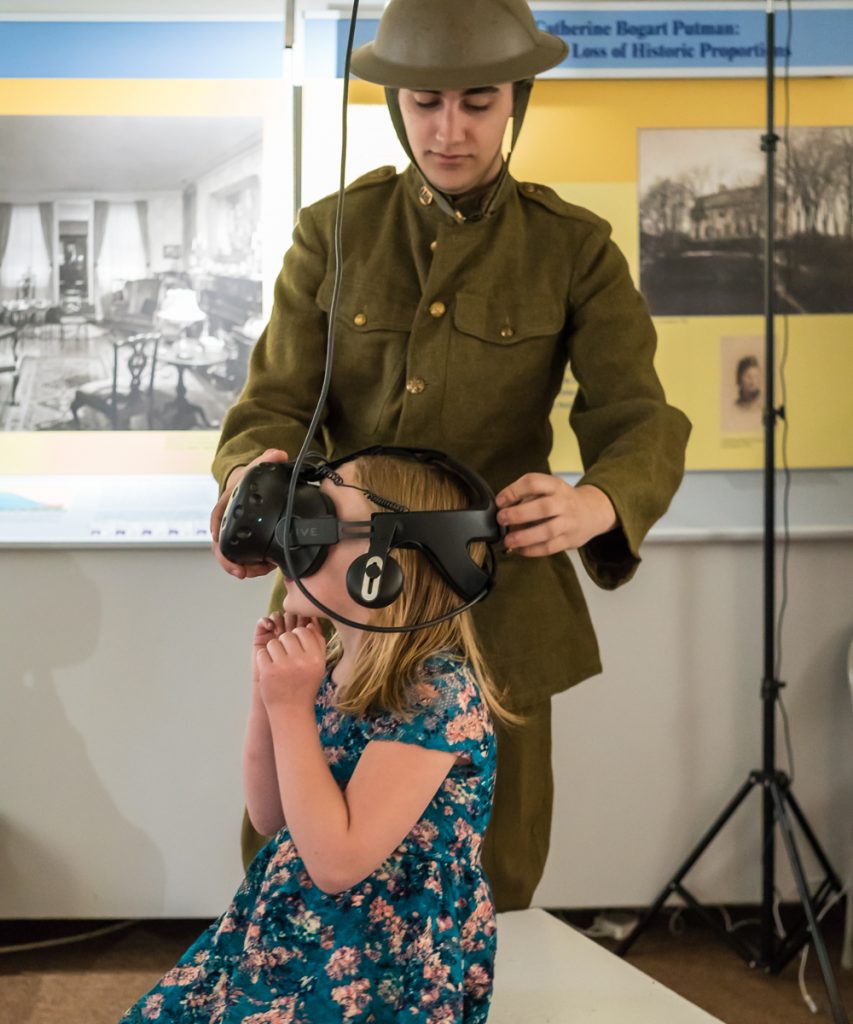
HNY: What were visitor responses to the Virtual Reality technology?
Mike: Going into it, I thought that young kids were going to be super excited and that it was going to be like pulling teeth to get someone over fifty to even consider it. It wasn’t that whatsoever. Everybody wanted to do it. The challenge will lie in keeping the young kids entertained with it, because they are so much more used to it.
Older participants had really interesting responses. Some went as far as reaching to console the person who was dying, and really trying to embrace them. There were people who were talking to the characters. Because it was a video that was done ahead of time, the characters were obviously not responding. But participants still felt the need to talk them and give them advice. There were people who, once the headset came off, they were frozen in time.
Krysta: There is the simple fact that Virtual Reality is pretty new. It’s exciting and people want to do it. It’s a great way to drag people who don’t know how interested they’re going to be in history to historic spaces. People do say what a cool experience it is to be in the virtual world, but what I hear more is that they want to talk about the people and what happened. They want to talk about the Spanish Flu epidemic. Great! You are talking about history. It’s a trick. It’s smoke and mirrors to make people care about history. It is a gateway drug to historic places.
HNY: Now that Siena College has the VR technology, what’s next?
Mike: The startup investment—which is getting the headsets and getting the computers that can support that kind of material, which is not your average computer—is now leading into this great future. Now the sky’s the limit because the pieces are in place. It’s now about creating more content.
The Computer Science department on campus, with Robin Flatland, they’re doing the actual virtual content without a camera and creating it from scratch. That takes animation skill sets. They are actually coming to us for the theatrical elements: how to set the scene, what do your operators do. They’re coming to us for that. It’s a really good thing that they’re also at our school.
Krysta: We’ll certainly be integrating it into the classes, into the creative arts. I’ve got it on my syllabus. To look at the artistic possibilities. People need to look at these things not as just games, but as a tool to understand other places, other times that we can’t visit otherwise.
Mike: A lot of our next focus is to make it even more interactive and to incorporate more of the hands-on virtual stuff. It’s one thing to transport someone to a different time period in a different location and put them in the environment. It’s another thing to be able to pick up a pill bottle and hand it to Sergeant Hennessy to give to the guys.
Krysta: It gives you agency in the space in a way that makes you a part of it in a way that nothing else can really allow you to be a part of history. Once we get the hands moving, we can give people roles. Are you a servant being asked to do something? Are you a guest being offered something? That is where I want to go next–making the spectator more significant and giving them more agency in the VR experience.
HNY: What resources, partnerships, and infrastructure does an organization need to have in place in order to develop a Virtual Reality experience?
Mike: For other organizations that want to try VR, you definitely need the people to do it. You need someone who understands video, video editing, computers, and at least an understanding of the VR technology to get it up and running. Also, having someone who understands theatre and who can set the stage is extremely important. To really do it right, the theatrical aspect of it is not just what happens in the headset but the first thing you see when you walk in the door, it’s how you’re greeted, it’s the people who are putting you in the headset. To have the operator play a character and engage with you, and to keep you occupied if you were early for your time slot, adds to the whole experience.
Krysta: We worked with the operators for a long time on basically bedside manner– or VR-side manner. They were embodying these two WWI characters that they worked on. We talked to Kimberly LaMay, a history professor here, about the era so that they could ad lib in context and always make sure that people felt comfortable in the space. I think that’s really important.
The curation of the whole environment, not just the virtual environment, is vital. That’s the most important thing that I would share with any organization that wants to do some work with Virtual Reality: do not spend all of your time and energy and resources on only the virtual environment, but take the time to think carefully about the live environment around the VR.
Deborah: We could not have done it without the partnership with Siena. Our resources are very limited, from financial to human. Developing this relationship with Krysta, with Siena, and with Humanities New York was absolutely critical to making this happen.
Krysta: The Virtual Reality would have been impossible without the grant. In the Creative Arts Department, we are fairly rich in human resources, but poor in the other kind. It would not have happened without Humanities New York.
HNY: What role might technology play in museums and cultural spaces over the next few years? How might it change these spaces?
Deborah: This is anecdotal, but during the fall semester I taught an intro to public history class. My students were tasked with evaluating a museum experience. There were two themes that kept coming up. One was the students emphasizing technology and the need for more technology, many of them imagining visiting historic house museums and having a hologram giving a tour. But what I found really interesting was there was also a strong emphasis on the importance of human interaction and the extraordinary value of discussion. This is one more opportunity to say that it’s not either or, thankfully. Technology and these virtual experiences can add so much to the museum experience. At the same time, there is also this need to step away from the virtual experience and talk to the person next to you and share reactions to it. So many students discussed the value of that human exchange. Having the opportunity to have both of them part of the museum experience is a wonderful thing that we’ve been able to begin exploring.
Mike: I would agree. In history, I don’t think Virtual Reality will stand on its own. You still need the historian, someone to interact with, even a friend to bounce ideas off of and think about the past.
Krysta: I think in many cases VR will be useful for layering the key information in museums. You might be sitting in someone’s living room and engaging with that space as you find out they were involved in a military campaign, or something more sinister like the slave trade. We can have that juxtaposition of the comfortable living room, and have visitors put on this virtual headset and go see where the money came from to build all of this. I think that is going to be a really interesting use, putting different places in dialogue with one another.
There’s not a whole lot to fear, but there’s only a lot of augmentation that can be done in spaces. It doesn’t kill the conversation; it creates more fodder for that conversation: What experience did you have? Where did you look? Why? All of these things can be explored. Technology moves so quickly that the implications for historic spaces within the next 20 years are beyond our wildest dreams, which I find incredibly exciting.
HNY: Why do the humanities matter to you?
Krysta: Our postmodern world is a mire of multiple and competing narratives. The only way to understand the perspective of the “other” is through their stories. The humanities give us control over language and rhetoric, which in turn allows us to communicate our emotion and make sense of our actions as empathetic beings. Science may teach us how to build things, but the humanities teach us what to build and why.
Deborah: Humanities are the study of what is means to be human—and that is pretty elemental. In the case of history, the study of past human experiences gives context to our lives today. As we look at our forebears and consider their responses to the circumstances that surrounded them, we are empowered to examine our own responses to the structural forces that comprise our “moment” in history, and that–one would hope–can make us better citizens of the global community.
Interview by Scarlett Rebman, Grants Officer
Photography by Ron Schubin
Keep up with Humanities New York, join our newsletter.
- To plan your visit to Historic Cherry Hill, visit their website.
- Learn more about Siena College’s Creative Arts Department here.
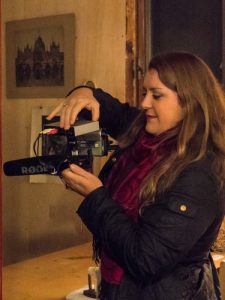 Krysta Dennis: Dr. Krysta Dennis works as a theatre-maker and director in the US and internationally, and teaches at Siena College. Krysta holds a dual PhD from the University of Kent in the UK and the Sorbonne in Paris, and trained as a performer at L’Ecole Jacques Lecoq. She is the author of three plays, Votes for Women, The Burden of the Ballot, and Dutch, which have been produced at Siena College, Arts Letters & Numbers, the New York State Attorney General’s Office, the Arkell Museum, Historic Cherry Hill, Ten Broeck Mansion, and the New York State Museum. She has received several Humanities NY Grants for her work. Krysta enjoys employing innovative theatre technology in her work, utilizing video mapping technology in her production of Arcadia at Siena College, and Virtual Reality technology mixed with live performance for Dutch at Historic Cherry Hill.
Krysta Dennis: Dr. Krysta Dennis works as a theatre-maker and director in the US and internationally, and teaches at Siena College. Krysta holds a dual PhD from the University of Kent in the UK and the Sorbonne in Paris, and trained as a performer at L’Ecole Jacques Lecoq. She is the author of three plays, Votes for Women, The Burden of the Ballot, and Dutch, which have been produced at Siena College, Arts Letters & Numbers, the New York State Attorney General’s Office, the Arkell Museum, Historic Cherry Hill, Ten Broeck Mansion, and the New York State Museum. She has received several Humanities NY Grants for her work. Krysta enjoys employing innovative theatre technology in her work, utilizing video mapping technology in her production of Arcadia at Siena College, and Virtual Reality technology mixed with live performance for Dutch at Historic Cherry Hill.
 Deborah Emmons-Andarawis: A native of New York City, Deborah Emmons-Andarawis received her bachelor’s degree from Barnard College, Columbia University, and continued her studies at the University at Albany, State University of New York, receiving a master’s in Public History in 2009. Deborah has been at Historic Cherry Hill since 2008, serving as Curator and Collections Manager and, since December of 2017, as Acting Director. Over her tenure, Deborah has helped to oversee a major restoration project, collaborated on numerous interpretive programs, and enhanced the profile of Historic Cherry Hill’s Edward Frisbee Center for Collections & Research. When not “working,” Deborah can be found running after her toddler or, on a very good day, sitting by the pond with her husband and son listening to the peepers.
Deborah Emmons-Andarawis: A native of New York City, Deborah Emmons-Andarawis received her bachelor’s degree from Barnard College, Columbia University, and continued her studies at the University at Albany, State University of New York, receiving a master’s in Public History in 2009. Deborah has been at Historic Cherry Hill since 2008, serving as Curator and Collections Manager and, since December of 2017, as Acting Director. Over her tenure, Deborah has helped to oversee a major restoration project, collaborated on numerous interpretive programs, and enhanced the profile of Historic Cherry Hill’s Edward Frisbee Center for Collections & Research. When not “working,” Deborah can be found running after her toddler or, on a very good day, sitting by the pond with her husband and son listening to the peepers.
 Michael Lounello: Michael is a native of the Capital District and the theatre technology manager at Siena College. Michael has spent most of his professional career as a concert lighting designer. Michael enjoys implementing innovative technologies in his theatre design practice such as video mapping, virtual reality, mixed media, and augmented reality. Michael enjoys turning artists’ visions into reality, by implementing and augmenting existing technology. In Michael’s free time, he can be found rewiring his house to make it an automated smart home, and taking landscape photography.
Michael Lounello: Michael is a native of the Capital District and the theatre technology manager at Siena College. Michael has spent most of his professional career as a concert lighting designer. Michael enjoys implementing innovative technologies in his theatre design practice such as video mapping, virtual reality, mixed media, and augmented reality. Michael enjoys turning artists’ visions into reality, by implementing and augmenting existing technology. In Michael’s free time, he can be found rewiring his house to make it an automated smart home, and taking landscape photography.

